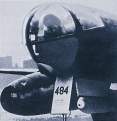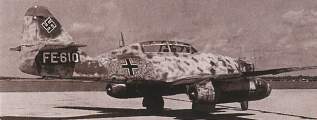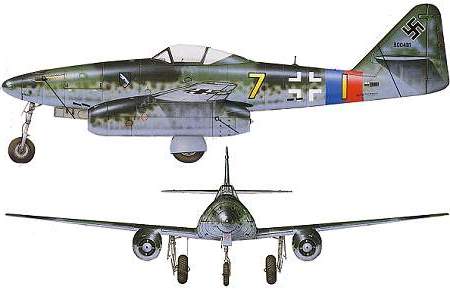
Messerschmitt Me 262
The Messerschmitt Me 262 reached the battlefield too late to have a profound effect on the outcome of the war, but it was one of those wonder weapons which awed the world and had completely revolutionize the face of air superiority warfare. Powered by the Junkers Jumo 004-B1 twin jet engines, the Me 262 was easily the fastest and most advanced aircraft in the world. Armed with forward firing cannons and unguided R4M rockets, this jet fighter could shoot down any Allied aircraft almost with impunity. This incredible aircraft achieved unconventional performance, far beyond the capabilities of any aircraft then in service, or under development. It was only through massive Allied bombings which laid waste to the German war industry which hindered production of this revolutionary aircraft.
The Me 262 was first conceived in 1939, but it was not initially planned to be a jet plane. When the first prototype flew on April 4 1941, it was still powered by a conventional piston engine, the Junkers Jumo 210G. The first jet powered flight took place on July 18 1942, where it had a tail wheel configuration and when it landed, unburned fuel was prone to ignite making landings very hazardous. The unsatisfactory layout was then changed to a fully retractable tricycle design, where it became the first production model, the Me 262A-1a “Schwalbe” (Swallow). Powered by twin Junkers Jumo 004B-1 turbojets, each engine delivered about 1,900 lbs of thrust, making this interceptor the fastest aircraft in the world. These early engines had a service life of only 25 hours, and had to be overhauled every 10 hours. The armament comprised of four Mk 108A 30mm cannons in the nose, while the Me 262A-1b version carried an additional 24 R4M 55mm unguided rockets under its wings. Although the Me 262 handled well at high speeds, it was sluggish and awkward at low speeds.

The Me 262 performed well in its role as an interceptor, but Hitler insisted that it should also be capable of carrying out bombing missions. That gave rise to the Me 262A-2a “Sturmvogel” (Stormbird), where its weaponry was reconfigured to carry two 500 pound bombs or a single 1000 pound bomb. It still retained its four cannons in the nose. Further trials led to the precision bomber variants, the Me 262A-2a/U1 and the Me 262A-2a/U2 version. The former had two of its nose cannons replaced by a bomb aiming device and the latter had a position in the nose to carry a bombardier who lay face down and peered through the glazed nose.
The Me 262 was also produced as two seater variants. The Me 262B-1a was built as a trainer while the Me 262B-1a/U1 was a night fighter. It had radar in its nose and carried a second crew member to operate the equipment. They could have been the best night fighters of the war, but less than a dozen of these had entered service by war’s end. Other variants include reconnaissance and antitank roles.
First delivered in May 1944, the Me 262 saw its first combat in September 1944. A total of 1,433 of all variants had been built, but had been converted to bomber roles, a decision which hindered the capabilities offered by this kind of warplane. Of those constructed, fewer than 300 had actually saw combat. Being a case of too few, too late, and inappropriately used, the Me 262 striked fear into Allied pilots, but could not alter the outcome of the war.
After the war, the Me 262 continued to influence modern jet plane designs, where its secrets helped the Americans, British and Russians to develop more advanced jet fighters leading up to the Cold war era. The USAAF Bell X-1, the first aircraft to achieve Mach 1 speeds on October 14 1947 was based on many lessons learnt from German scientists and captured Me 262 blueprint.
 |
 |
 |
| The Night Fighter variant is equipped with radar on the nose, and had a second pilot to operate it in the back. |
The Me 262 was built both as a fighter and precision bomber version. |
The single seat Me 262 fighter. The jet engines had a lifespan of just 25 hours. |
|
Messerschmitt Me 262 (Technical Specification) |
| Role |
Air Superiority Fighter |
| Manufacturer |
Messerschmitt |
| Maximum Speed |
870 kmh (540 mph) |
| Maximum Range |
1050 km (650 miles) |
| Ceiling |
11,450 meters (37,500 feet) |
Weight
Empty
Maximum Takeoff |
3,800 kg (8,738 lbs)
6,400 kg (14,110 lbs) |
Dimensions
Wingspan
Length
Height
Wing Area |
12.50 meters (40 ft, 11 in)
10.58 meters (34 ft, 9 in)
3.83 meters (12 ft, 7 in)
21.73 square meters (234 sq ft) |
| Engines |
Two Junkers Jumo 004B-1/-2/-3 each providing 8.82-kN (1,980 lbs) thrust |
| Armament |
Four Rheinmetall Borsig Mk 108A-3 30mm cannons in the nose
Twelve R4M spin stabilised unguided rockets
Two 226 kg (500 lbs) bombs or one 452 kg (1,000 lbs) bomb
|
| Number Built |
1,433 |
Photo Gallery
Click here to submit your photo
| Have A Passion For Aircraft? |
Subscribe to our 14 series FREE newsletter
delivered weekly on World War 2 Aircraft factfile... |
| NB:- We hate spam as much as you do, so your email address will NEVER be shared with or sold to anyone else. That's a Guarantee. |
|
|








